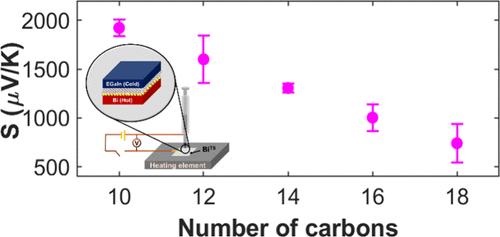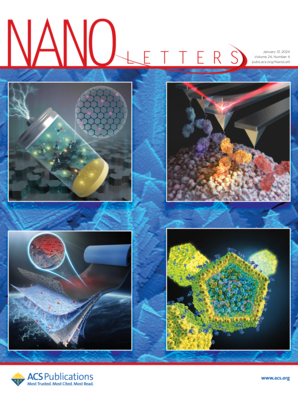Unusually High Thermopower in Molecular Junctions from Molecularly Induced Quantized States in Their Semimetal Leads
IF 9.6
1区 材料科学
Q1 CHEMISTRY, MULTIDISCIPLINARY
引用次数: 0
Abstract
The efficiency of a thermoelectric (TE) device depends on the extent to which its electron/hole transport symmetry at the Fermi level is broken. This requirement makes molecular junctions promising for TE applications as their transmission characteristics are highly nonlinear. Yet, in the absence of an efficient method to tune the position of the Fermi level within their transmission landscape, the typical Seebeck values of metal–molecules–metal junctions are |S| ≤ 100 μV/K, while considering their electrical and thermal conductance, it should be |S| ≥ 1 mV/K to be relevant for applications. Here, we report metal–molecules–semimetal junctions with |S| in the required mV/K range. This is achieved by molecularly induced quantized two-dimensional (2D) interfacial states within the semimetal that result in nonlinear features in their transmission properties. The importance of the presented approach goes beyond TE applications as it demonstrates a novel strategy to form and tune 2D interfacial layers within bulk materials by molecular monolayers.

求助全文
约1分钟内获得全文
求助全文
来源期刊

Nano Letters
工程技术-材料科学:综合
CiteScore
16.80
自引率
2.80%
发文量
1182
审稿时长
1.4 months
期刊介绍:
Nano Letters serves as a dynamic platform for promptly disseminating original results in fundamental, applied, and emerging research across all facets of nanoscience and nanotechnology. A pivotal criterion for inclusion within Nano Letters is the convergence of at least two different areas or disciplines, ensuring a rich interdisciplinary scope. The journal is dedicated to fostering exploration in diverse areas, including:
- Experimental and theoretical findings on physical, chemical, and biological phenomena at the nanoscale
- Synthesis, characterization, and processing of organic, inorganic, polymer, and hybrid nanomaterials through physical, chemical, and biological methodologies
- Modeling and simulation of synthetic, assembly, and interaction processes
- Realization of integrated nanostructures and nano-engineered devices exhibiting advanced performance
- Applications of nanoscale materials in living and environmental systems
Nano Letters is committed to advancing and showcasing groundbreaking research that intersects various domains, fostering innovation and collaboration in the ever-evolving field of nanoscience and nanotechnology.
 求助内容:
求助内容: 应助结果提醒方式:
应助结果提醒方式:


